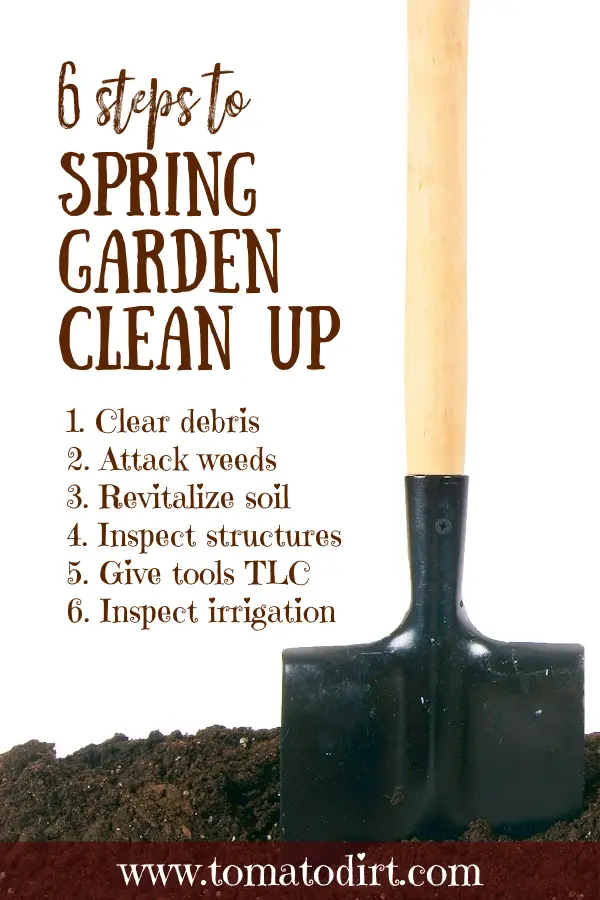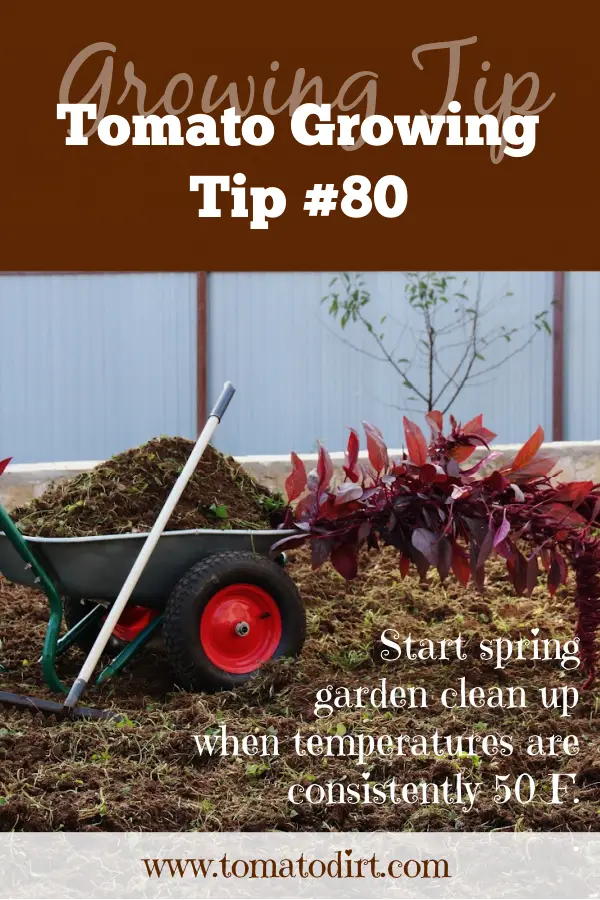FREE: 10 Must-Know Tomato Growing Tips Get The Guide
Read our affiliate disclosure here.
Spring Garden Clean Up: Get Your Garden Ready for the Season
Since 2010, Tomato Dirt has garnered 4.8+ million views, making it the web’s leading online source for growing tomatoes in the home garden. Award-winning writer and Tomato Dirt owner Kathy Widenhouse has helped thousands of home gardeners grow healthier tomatoes. Be one of them when you get Tomato Dirt’s Growing Guide here.
Updated 10.28.24
Your fingers have been itching to get into the dirt all winter long. That’s one reason spring garden clean up is less of a chore and more of a “Welcome Back!” party. It’s fun to get outside and work the soil after being cooped up indoors for weeks on end.
Plus, when you get your soil and tools ready in early spring, you get a sense of order. The garden simply looks better when you’ve cleared out and prepared for the new season – even if the trees are still bare.
On a practical note, tidying up the vegetable garden early allows you to get your preliminary work completed ahead of time, which means planting tomatoes and other garden crops goes quickly. And with seedlings and seeds in the ground faster, your results come sooner.
All in all, spring garden clean up is win-win. But spring can last for months. When should you begin to put things in order in your vegetable garden?
When to start spring garden clean up
It’s a particularly tricky question when the weather is warm for a few days in a row and you simply cannot resist a few trips out to the garden.
But a word of caution. There’s good reason gardeners avoid garden clean up in the fall and even wait until it’s time to plant. They’re not procrastinating. They’re promoting microbes to multiply in the garden debris and encouraging more pollinators to overwinter for the new season. Bees and butterflies, for instance, spend the cold months in plant brush.
On the other hand, so do fungi, which are among a tomato gardener’s sworn enemies.
So you can see the challenge to timing your spring garden clean up. Should you allow helpful bugs to stay asleep a bit longer … or should you eliminate annoying pests and pathogens as soon as possible? It may be weeks or months before your ground is warm enough to set plants and seeds out. At the same time, you want to give pollinators a chance.
Whether or not you put your vegetable plot in order at the end of last season, the fact of the matter is this: spring is the time to step up and get it done.
Here’s Tomato Dirt’s best advice: when it comes to clearing debris and working the soil (#1-3 below), wait to start spring garden clean up until temperatures are consistently about 50 degrees F (10 C).
For clean up projects that involve tools, structures, and irrigation (#4-6 below) – well, go ahead just about any time.
When you’re ready, here’s a complete list of spring garden tasks to complete.

Just 6 steps: here's your spring garden clean up list
1. Clear debris
A key order of business is to bid farewell to winter's remnants. Even if you did a good job tidying up your vegetable bed at the end of the season, there’s plenty of pesky leftovers that accumulated during the intervening months.
Remove dead leaves, sticks, and any other debris that may have settled on your plot. If you didn’t clear out last year’s spent plants and mummified fruit, now is the time. By discarding debris, you give your garden a neat appearance – not bad in and of itself. At the same time, you reduce the risk of pests and diseases harboring in the brush.
2. Attack weeds
Pull out early weeds right now, before you plant a single seed or seedling. Doing so prevents these unwanted intruders from stealing nutrients from your precious crops. Weeding is easier now than later in the summer, thanks to the damp post-winter soil makes the soil loose and allows you to uproot weeds without difficulty. You can also lay down biodegradable weed mats, if you choose.
3. Revitalize the soil
Take this time to prepare your garden soil for the season. First, use a tiller or spade over the soil to aerate it. Then, break up any compacted areas.
While you’re there stomping through the damp earth, take a soil test to check your garden’s nutrient and chemical contents. Purchase an inexpensive soil test kit online or at a garden center. Or contact your local extension office and ask about local soil testing services.
To get the best overall reading of your garden plot’s soil, take a composite sample – an “average” of the soil in your entire garden. Select a clean bucket in which to collect samples. Choose 6-10 spots across your garden. Dig a 4-6” deep plug with a trowel or spade from each location, place each sample in the bucket, and mix the samples together. Then follow instructions on your soil test kit or submit your sample to the local lab or garden extension for analysis.
While you’re waiting for the soil test results, spread organic matter (such as compost or well-rotted manure) over your garden to replenish the soil with essential nutrients after last year’s growing season.
Then, when you receive your soil test results, amend your garden as needed. For example, if your analysis shows a calcium deficiency then work in bone meal or lime to the plot. Doing so will not only help you grow healthier tomato plants – and in the case of sufficient calcium, will also help to prevent blossom end rot in the first fruit of your crop.
4. Inspect your garden structures
Examine your garden fences, trellises, tomato cages, and raised beds for damage and wear.
- Are fence posts secure?
- Are fence panels or rails gap-free, especially at the soil line?
- Are trellis lines rotted or broken?
- Are tomato cages bent or rusted?
- Are raised bed walls securely anchored in the ground?
Repair or replace garden structures as necessary to ensure they provide the needed support for your growing plants.
5. Give your tools some TLC
Your trusty gardening tools have weathered the winter alongside your garden – even if you stored them in the garage or garden shed. Give them some attention now so they’re ready to help you when the weather gets warm.
- Clean off dirt or rust.
- Wash tools in warm soapy water. Let them air dry.
- Disinfect tools with a 10% bleach solution to destroy unnecessary pathogens.
- Oil the metal surfaces.
- Sharpen blades so they are ready for the upcoming tasks.
6. Inspect your irrigation
Heat: you know it’s coming. And one of the best ways to prepare for it is to ensure you’re your watering system is in tip-top shape. Consistent watering is an important key to a healthy tomato crop.
- Check hoses, nozzles, and sprinklers for leaks, clogs, or damaged components. Replace parts as needed.
- Evaluate water pressure.
- Test your water timers and water usage meters to make sure they’re in working order.
- Remember that plastic milk jugs are a no-cost way to keep individual tomato plants hydrated. Start collecting jugs now so you’re ready to set them out with your seedlings at planting time.
Other spring garden clean up tips
Some gardeners swear by adding a fresh layer of mulch to your garden soil surface before the season begins. Mulch helps retain moisture, suppress weeds, and regulate soil temperature. It's a protective blanket for your garden, providing a conducive environment for plant growth.
However, it’s best to wait to mulch tomato plants until the soil has warmed – about 3-5 weeks after setting plants in the garden. Tomatoes like heat.
So the jury is out as to whether or not mulching is a chore for your spring garden clean up list.
One approach is to spread black plastic over your garden surface. It’s a season-long solution to mulching. Black plastic keeps moisture in and weeds down. And you can lay it down anytime in the spring.
The growing season is just around the corner – but you can start enjoying your vegetable garden now by taking a few spring garden clean up steps sooner than later.
More about getting your garden ready for planting
How to plan a garden layout for growing vegetables and tomatoes ...
3 Ways to Prepare Your Garden for Spring ...
Preparing your soil for planting tomatoes ...
How to Take a Soil Test in Your Tomato Garden ...
How To Improve Your Garden Soil Over Winter ...
More tips for preparing your soil on our Pinterest board ...
Return from Spring Garden Clean Up to Tomato Dirt home
As an Amazon Associate and Rakuten Advertising affiliate I earn from qualifying purchases.
SHARE THIS PAGE:
FREE! 10 Must-Know Tomato Growing Tips: 20-page guide
Get yours here:




